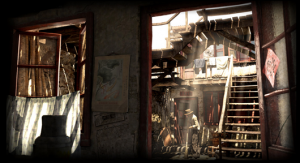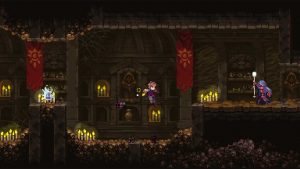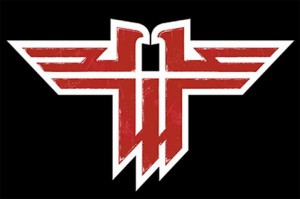Back when Ken Levine announced his departure from Irrational Games, to pursue a different creative experience, it came as no surprise that others also wished to focus their efforts in a small studio environment. The Molasses Flood is a new studio created, mostly, by former employees of Irrational Games including Art Director Scott Sinclair, and Lead Level Designer Forrest Dowling, who was kind enough to sit down and talk about their first project The Flame in the Flood.
Already successfully funded on Kickstarter at over $200,000, The Flame in the Flood is a rogue-like survival experience that sets itself apart with its’ unique backwater style and emphasis on the perils of Mother Nature. The Molasses Flood utilized the expected random level generation in a different way, replacing dungeons with river rapids and swamp riddled woods that host a variety of dangers. Players control the character Scout as she travels with her loyal dog Aesop as they journey to the end of the river against rapids, hunger, natural predators, and much more.
Dowling, a veteran of AAA development, discussed how this new studio formed, what the small teams’ hopes are for their project, and some financial facts regarding the development of a game on this scale.
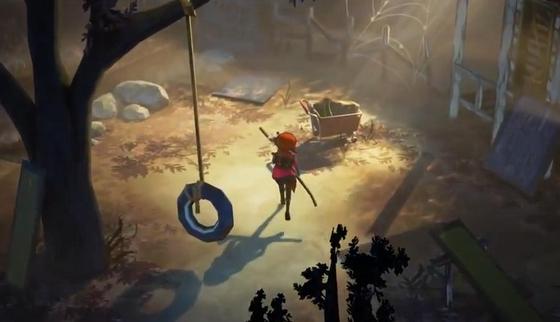
Jesse Tannous: It seems like your entire team had worked on some part of BioShock Infinite, is that where you all came together? How did this partnership come about?
Forrest Dowling: Almost the entire team worked on Infinite. Bryn worked at Irrational years ago, around the time of Freedom Force. The rest of us knew each other through working on Infinite. The partnership came about after the closure of Irrational. There were suddenly a lot of talented developers in a town without a lot of jobs available in games. We knew we’d all have to move or start something new. Around that time, Damian was finishing up his own project, Third Eye Crime, and was looking for a new team to work with. We convinced Bryn to leave his job at Harmonix to come join us. Working on a small team on your own project is a pretty appealing idea for a lot of developers, so it wasn’t a very tough sell. The hardest part was convincing everyone to forego a salary for the unknowns of indie development.
JT: So far how has the team enjoyed the smaller studio environment as compared to working on something as large as the BioShock franchise? What have been some of the key differences?
FD: The biggest difference is scope and resources. Working on a large project means that you can do just about anything you can think up. If you need a voice actor, or motion capture, or weeks of an artist’s time, it can be done. Now we have 6 of us. If an idea can’t be done by someone in the room, in a reasonable amount of time, it’s not happening. That being said, on a large project you can do anything, but you can’t do everything, so we’ve always had to worry about scope. It’s just a much lower threshold now. One big advantage of working on a small team is nimbleness and speed. If I need a new tool written by an engineer, I can get it almost immediately. On a large team, there’s always more steps along the way, and changing things means fighting a lot more inertia.
JT: While a $150,000 Kickstarter goal is not the highest, especially considering previous video game projects that have appeared on the website, but it is on the higher end. What was the main motivation for setting a higher Kickstarter goal like this, especially when backers seem fully willing to fund projects well-beyond their stated goals?
FD: We set the goal at the lowest point that we felt we could and still make the game. $150,000 really is a shoestring budget for a game of the size we’re making. If we set it lower, there would be a risk of hitting the goal, but not blowing past it. At that point, we’d be in a pretty bad position, in that we’d have some of what we needed, but not all of it. I’d rather miss an honest goal then set one that was too low and hit it, leaving us unable to deliver what we promised. While backers are willing to go beyond funding targets, it seemed really dangerous for us to count on that.
JT: You state in your Kickstarter that you are combining self-funding, and crowd-funding in order to make this game a possibility. For those less experienced with developing a game on this scale how much does it really cost to put something like this together and how does it break down?
FD: That’s a good question. Not so long ago, Tim Schafer tweeted a number. It takes about $10k a month per developer to run a studio. That’s pretty accurate when averaged over a large team. You have some entry level people who make a bit less, and senior engineers can make a bit more. So for us, if we were just bankrolling this project and hiring experienced developers, the napkin math would point to about $720,000 in payroll alone.
Considering that we’re all pretty experienced, I’m guessing hiring the 6 of us at a major studio would even run a little higher. Payroll is the single biggest expense in making games, particularly on the engineering side, as you’re competing with Google and Facebook to hire people. Beyond that there’s QA, localization, certification costs, marketing costs… those can all be extremely variable and shift based on how many platforms you’re supporting.
At a baseline, if someone wanted to hire the group of us to make this game, they would probably need to budget close to a million. Fortunately, we can make this game for a lot less because we’re dramatically decreasing the biggest cost, payroll, by living off savings. We’re willing to do this because we’re not working for a paycheck, we are hoping that we’re building a studio that is ours for years to come.
JT: How did Chuck Ragan get involved in this project?
FD: Chuck and Scott Sinclair go way back. Sinc has done most the album covers for Chuck’s previous band, Hot Water Music, and their bands used to play the same shows back in Sinc’s college days. While we were figuring out what we wanted to make, I had initially proposed looking at traditional American acoustic music, folk, bluegrass, that sort of thing. Sinc proposed that we see if Chuck was interested. We approached him, told him about what we wanted to do, and he was immediately interested and wanted to help out.
JT: Are there any plans to update or add expansions to Flame in the Flood after it has been released?
FD: While the game could be expanded pretty easily, we’re just focused on the core experience right now. If it does well and people love it, we’d consider additional content down the line, but that’s pretty far off and not something we’re really thinking about right now.
The Flame in the Flood will have its’ own challenges to survive throughout the development process, but with the popularity of rogue-like games and the professional experience The Molasses Flood brings to the table, it could be the perfect move for a young studio hoping to make a name for itself in the wake of the Irrational Games closure.
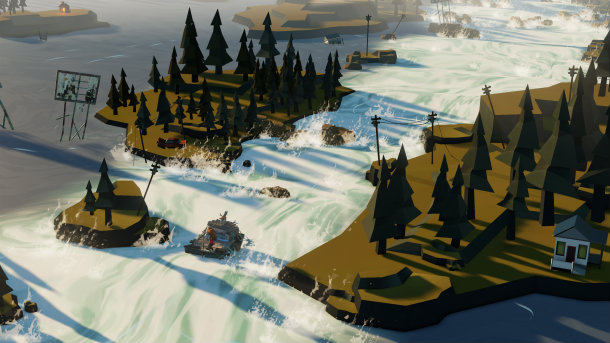
Jesse is a reporter first who just happens to love video games and enjoys writing video game related articles and interviewing industry professionals.

